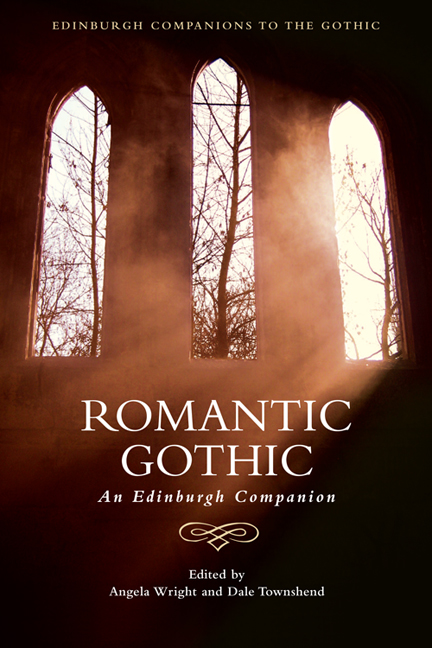Book contents
- Frontmatter
- Contents
- 1 Gothic and Romantic: An Historical Overview
- Part I Gothic Modes and Forms
- 2 Graveyard Writing and the Rise of the Gothic
- 3 Gothic Romance
- 4 The Gothic Stage: Visions of Instability, Performances of Anxiety
- 5 Gothic Poetry and First-Generation Romanticism
- 6 Gothic and Second-Generation Romanticism: Lord Byron, P. B. Shelley, John Polidori and Mary Shelley
- 7 Political Gothic Fiction
- 8 Shorter Gothic Fictions: Ballads and Chapbooks, Tales and Fragments
- 9 Oriental Gothic
- 10 Gothic Parody
- Part II National and International Borders
- Part III Reading the Romantic Gothic
- Notes on Contributors
- Index
5 - Gothic Poetry and First-Generation Romanticism
from Part I - Gothic Modes and Forms
Published online by Cambridge University Press: 05 August 2016
- Frontmatter
- Contents
- 1 Gothic and Romantic: An Historical Overview
- Part I Gothic Modes and Forms
- 2 Graveyard Writing and the Rise of the Gothic
- 3 Gothic Romance
- 4 The Gothic Stage: Visions of Instability, Performances of Anxiety
- 5 Gothic Poetry and First-Generation Romanticism
- 6 Gothic and Second-Generation Romanticism: Lord Byron, P. B. Shelley, John Polidori and Mary Shelley
- 7 Political Gothic Fiction
- 8 Shorter Gothic Fictions: Ballads and Chapbooks, Tales and Fragments
- 9 Oriental Gothic
- 10 Gothic Parody
- Part II National and International Borders
- Part III Reading the Romantic Gothic
- Notes on Contributors
- Index
Summary
Horace Walpole stages his ur-Gothic text, The Castle of Otranto (1764), as a stage management of the Gothic itself: ‘The characters are well drawn, and still better maintained. Terror, the author's principal engine, prevents the story from ever languishing; and it is so often contrasted by pity, that the mind is kept up in a constant vicissitude of interesting passions’ (Walpole 1765: v–vi). Fuelling the Gothic's well-oiled ‘engine’, Walpole emphasises maintenance but also ‘constant vicissitude’ lest things fall into entropy. Change is thus essential as well as inevitable. On one hand, one never quite knows where ‘Terror’ lies; on the other, randomness requires fear in order to redraw the boundary between self and world, as in theories of the sublime outlined in Edmund Burke's A Philosophical Enquiry into the Origin of Our Ideas of the Sublime and Beautiful (1757) and later Immanuel Kant's Critique of Judgment (1790). Walpole simulates ‘interesting passions’ in order to stimulate a visceral response. In order to feel reality as real one must experience it as fake, must feel within our habitual world a reality it has forgotten. Put another way, the Gothic expresses paranoia that Enlightenment reason might be as volatile or anachronistic as the histories and customs it forced underground. As Fred Botting argues, ‘Darkness threatened the light of reason with what it did not know’ (Botting 1996: 30), a sublime encounter that forces reason to recalibrate its overpowering ‘experience of loss and negativity … through an imaginative and active process’ (Botting 1996: 8) that re-inscribes codes and limits. Yet this encounter also marks reason's disturbingly productive encounter with curiosity, desire and enjoyment of transgressing what we think is ‘normal’. Or as both Burke's and Kant's theories suggest, something in us asks for the contrived reproduction of conditions to induce a real response of fear in order to jolt us out of the complacency produced by the equally contrived nature of everyday life in an increasingly industrialised, technologised and commercialised society.
Emerging sensationally in the eighteenth century, the Gothic addresses unseen, unknown and unacknowledged aspects of human existence left unexplained by religion or science.
- Type
- Chapter
- Information
- Romantic GothicAn Edinburgh Companion, pp. 95 - 111Publisher: Edinburgh University PressPrint publication year: 2015



